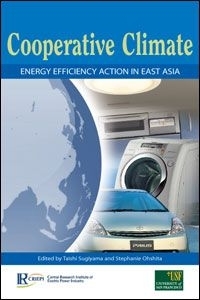Cooperative Climate: Introduction
The purpose of this book is to identify a promising modality of energy efficiency cooperation within East Asia.[1] Energy efficiency is of interest to all countries in the region, and a key pillar for climate change mitigation. In order to explore cooperation opportunities in greater detail, international research experts collaborated for one year. This book is the product of this collaboration.
On the international climate change front, cooperation on the dissemination of energy technologies has been raised as a possible supplement or alternative to the greenhouse gas emissions cap approach—represented by the Kyoto Protocol (Kyoto Protocol to the United Nations Framework Convention on Climate Change (full text))—to mitigate climate change. However, the discussions so far have been conceptual, and detailed design issues have been largely absent. In this project, we explore the potential for creating a regional agreement to foster the development and deployment of energy-efficient technologies.
The major outcome of our project is a concrete proposal for a Policy Development Fund dedicated to energy efficiency cooperation within East Asia. This proposal is designed to be practical and timely, such that government and industry should be able to implement it immediately. The proposal is based on a comprehensive analysis of energy efficiency cooperation within East Asia. Through our findings, we aim to convince readers that the Policy Development Fund is a vital step forward in achieving energy efficiency and reducing greenhouse gas emissions.
The new Fund would not necessarily diminish existing cooperative activities. Rather, the opposite is true. Our proposal builds upon the rich experiences of the past—and tries to create more of them in the future.
The rest of the book is structured as follows. Part I (Chapters 1 (Cooperative Climate: Introduction) and 2 (Cooperative Climate: Introduction)) introduces the research effort behind the book and provides background on energy efficiency activities within individual East Asian countries.Part II (Chapters 3 (Cooperative Climate: Introduction) through 5 (Cooperative Climate: Introduction)) provides analysis of existing international cooperation for energy efficiency in East Asia. Part III (Chapter 6 (Cooperative Climate: Introduction)) is the specific proposal of the Policy Development Fund.
Note
|
|
Citation
Development, I., Heggelund, G., Meier, A., Ohshita, S., Sinton, J., Sugiyama, T., & Wiel, S. (2012). Cooperative Climate: Introduction. Retrieved from http://editors.eol.org/eoearth/wiki/Cooperative_Climate:_Introduction- ↑ The definition of East Asia varies across the literature. In the narrowest definition, it includes only Japan, Korea and China. A broader definition also includes ASEAN countries (Brunei, Cambodia, Indonesia, Laos, Malaysia, Myanmar, Philippines, Singapore, Thailand and Vietnam) and some other neighboring countries such as India. In this book, we adopt the broad definition with a focus on Japan, Korea and China.
